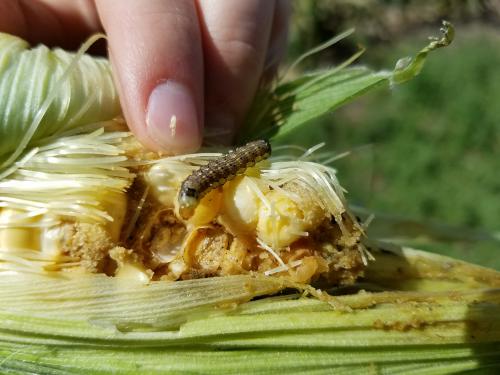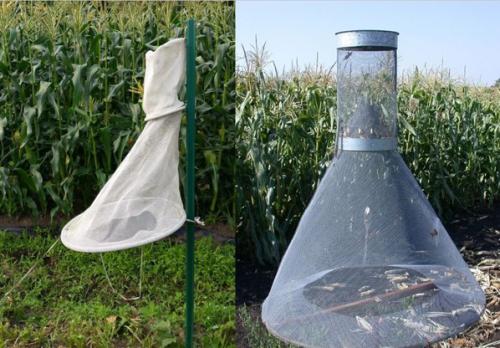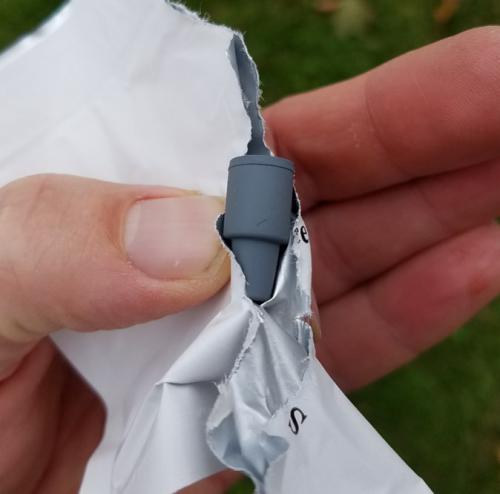Video tutorials on using pheromone traps to monitor corn ear worm in sweet corn
March 7, 2017 - Benjamin Werling and Marissa Schuh
Corn earworm biology
Corn earworm, or Helicoverpa zea, is the main target of insect pest control in Michigan sweet corn. This pest is migratory, journeying from the southern U.S. to the Midwest when south to north airflow develops (see weather model below). This means populations can change from non-damaging to heavy in a matter of days. Timing is key for protecting your corn once moths arrive. Females lay eggs on fresh green silks. Fresh silks need to be protected with insecticide before eggs hatch, so larvae contact it and die before entering the husk. This means prompt, well-timed insecticide applications are key for avoiding wormy corn.

This corn earworm escaped into the husk where insecticides cannot reach it.
Watch this video to learn how corn earworm biology makes timing critical for control.
Trap Assembly and Placement
Pheromone traps can help you detect flights of moths, so you can accurately time sprays to protect your silking corn. The three key ingredients for successful trapping are:
1. Traps: Heliothis or Hartstack traps (a.k.a. Texas Cone traps) can both be used to monitor earworm moths. Heliothis traps are readily available online. Michigan growers have fabricated their own Texas Cone traps (plans available below) and are also available for purchase.

A Heltiothis trap and (left) and a Hartstack Trap (right)
Photo credit : Eric Burkness, Bugwood.org
2. Lures: The most important part that is not included with traps are the lures, which will draw male moths into your trap. A calendar and planting schedule can help with calculations of how long green silks will be present across the farm, allowing the correct number of lures to be ordered. Look for the species name of corn earworm when choosing lures - Helicoverpa zea - as it goes by many common names, including tomato fruitworm and cotton bollworm.

A corn earworm lure, also known as a "septa."
| Suppliers of earworm traps and lures (updated 2017) | ||
|
Item |
Manufacturer(s) |
Manufacturer contact info |
|
Heliothis traps |
Scentry |
|
|
Hartstack traps |
Kevin Poppe’s Service |
309-365-3651 |
|
Lures |
Scentry, Trece |
|
3. Well-positioned traps: Trap placement is critical if you plan to use data to time sprays. Make sure your trap is placed on the windward edge of a field in a location where the wind will not be blocked by trees, allowing pheromones to be blown into your field. Females moths lay eggs on green silks, so make sure you move your trap from planting to planting so it is always near green silks.
Watch this video for information on how to assemble and place traps.
Checking traps, identifying moths, and making spray decisions
This video covers how to identify corn earworm moths, as well as how to check your trap. It also shows how to use moth catches to make spray decisions.
Checking your trap will be a slightly different procedure depending on which trap you are using. Because large flights of corn earworm can occur suddenly, traps should be checked at least twice a week. Quick identification of corn earworm moths relies on a couple characteristics -- the key things to look for will be size (1.25-1.5 inches) as well as the dark spot on the wings.
Corn earworm moths are on the tan to brown end of the color spectrum, and have a prominent black spot on the wing.
Photo credit: Eric Burkness, Bugwood.org
Once you identify and count your trap catch, you can use this information to make spray decisions. There are different thresholds for Hartstack and Heliothis traps. With Hartstack traps, research has shown different thresholds should be used to trigger sprays, depending on whether or not nearby field corn is silking. If counts are over threshold, spray intervals can also be tightened as captures increase. For Heliothis traps, The Ohio State University Extension has published thresholds, which can be found in “How to use pheromone traps to help manage corn earworm & European corn borer on sweet corn in Ohio.”
By monitoring your Hartstack trap and calculating the average number of moths being captured per day, you can make informed decisions about when and how often to spray (see the Midwest Vegetable Production Guide E-0312 for more information on corn earworm control). Thresholds and spray intervals can be adjusted based on the economics of production on your farm and your buyer’s quality standards.



 Print
Print Email
Email